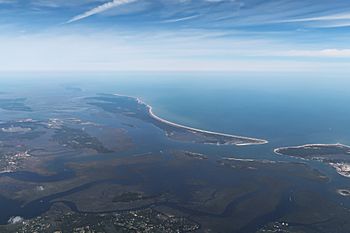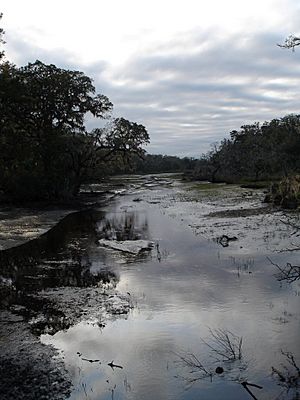Cumberland Island facts for kids

Aerial view of Cumberland Island
|
|
| Geography | |
|---|---|
| Location | Atlantic Ocean |
| Coordinates | 30°51′04″N 81°26′54″W / 30.85111°N 81.44833°W |
| Archipelago | Sea Islands |
| Area | 147.37 km2 (56.90 sq mi) |
| Length | 17.5 mi (28.2 km) |
| Administration | |
|
United States
|
|
| State | Georgia |
| County | Camden County |
Cumberland Island is the biggest of the Sea Islands in Georgia, located in the southeastern United States. It's famous for its amazing wildlife and has been named a National Seashore. Long ago, a special type of cotton called Sea Island cotton was first grown here. A local family, the Millers, even helped Eli Whitney create the cotton gin, a machine that made cleaning cotton much easier. A smaller island, Little Cumberland Island, is connected to the main island by a marsh.
Contents
Exploring Cumberland Island
Cumberland Island is part of Camden County, Georgia. It's the westernmost point of shoreline on the Atlantic Ocean in the United States. The island is about 17.5 miles (28.2 km) long. It covers an area of 36,415 acres (147.37 km2). This includes 16,850 acres (68.19 km2) of marsh, mudflats, and tidal creeks. There are no bridges to the island. You can only reach it by the Cumberland Ferry from St. Marys.
Island Ecosystems and Wildlife
Cumberland Island has three main types of natural areas. Along the western side, you'll find large salt marshes. These are wetlands with salty water. You can also see old, twisted live oak trees covered with Spanish moss. Palmetto plants grow at the edge of the island's thick maritime forest.
The island's most famous natural area is its beach. It stretches for over 17 miles (27 km). Many interesting animals live here, both native and those brought by people. You might spot white-tailed deer, squirrels, raccoons, and nine-banded armadillos. There are also wild boars, American alligators, and many animals that live in the marshes. The island is especially known for its feral horses. These wild horses roam freely across the island.
A Look Back in Time
Early Island Life
The first people lived on Cumberland Island as far back as 4,000 years ago. Later, people from the Savannah culture lived here. They spoke the Timucua language, specifically the Mocama dialect. In the 1600s, the Tacatacuru chiefdom controlled the island. Their main village was called Tacatacuru. It was located near the southern end of the island.
When the Spanish arrived in the 1550s, they named the island San Pedro. They built a fort and a mission called San Pedro de Mocama in 1603. This was an important mission center. Another Spanish mission, Puturiba, was on the island from 1595 to 1597. A third mission, San Phelipe, moved to the northern end of Cumberland Island from 1670 to 1684.
Records show that around 300 native people and several Spanish priests lived on the island until 1681. In 1683, French pirates attacked Cumberland Island. They stole things and burned buildings. Many native people and Spanish missionaries left the island. Another pirate attack in 1684 led the Spanish to finally leave the island. Many people had died from European diseases. The Tacatacuru people moved closer to St. Augustine. After that, the Yamasee people lived on Cumberland Island.
English Arrival and New Name
English General James Oglethorpe arrived in Georgia in 1733. In 1735, he made a deal with the Creek nation. They said they owned the coastal islands. Most of these islands, including Cumberland Island, were given to England. This caused problems with Spain, who also claimed the islands.
A young Yamacraw named Toonahowi suggested the name Cumberland Island. He was the nephew of Chief Tomochichi. He wanted to name it after William Augustus, the 13-year-old Prince William, Duke of Cumberland. He was the son of King George II.
In 1736, Oglethorpe built a fort called Fort St. Andrews in the north. A small village called Berrimacke was near the fort. In 1740, he built a second fort, Fort William, at the southern tip. These forts were built to protect English settlements from the Spanish in Florida. After the English won the Battle of Bloody Marsh in 1742, the forts were no longer needed. They were abandoned and eventually disappeared.
Plantation Life
Nathanael Greene, a hero from the Revolutionary War, came to own much of southern Cumberland Island. He died in 1786. Ten years later, his wife, Catharine Littlefield Greene, married Phineas Miller. They built a large, four-story mansion from a material called tabby. They named it Dungeness.
The mansion had very thick walls and many fireplaces. It was surrounded by 12 acres (4.9 ha) of gardens. Dungeness was a place for many fancy parties. Important leaders enjoyed the Millers' hospitality. During the War of 1812, the British used Dungeness as their headquarters. The Millers' Dungeness mansion burned down in 1866.
The Millers were the first to grow a lot of Sea Island cotton on Cumberland. They had 210 enslaved people working on their plantation. Catharine and Phineas Miller helped Eli Whitney create the cotton gin in 1793. This machine made it much faster to separate cotton fibers from seeds.
Other crops like indigo and rice were also grown. You can still see old rice fields on the island today. People say that live oak wood from the island was used to build the famous ship USS Constitution, also known as "Old Ironsides," in the 1790s.
In 1818, General "Lighthorse" Harry Lee, a Revolutionary War hero, became very ill. He asked to be taken to Dungeness. He died there on March 25 and was buried on the island. His son, Confederate General Robert E. Lee, visited his father's grave many times. In 1913, Harry Lee's body was moved to Virginia, but his gravestone stayed on Cumberland Island.
By the time of the Civil War, Robert Stafford was the main landowner on Cumberland Island. His grave is on the island's main road.
The Carnegie Family Era

In the 1880s, Thomas M. Carnegie, whose brother was the famous steel businessman Andrew Carnegie, and his wife Lucy bought land on Cumberland. They wanted a place to stay in the winter. In 1884, they started building a new mansion on the old Dungeness site. Thomas Carnegie died before it was finished.
Lucy and her nine children continued to live on the island. They also named their mansion Dungeness. It was a huge, 59-room castle. They built swimming pools, a golf course, and 40 smaller buildings. These buildings housed the 200 servants who worked at the mansion. The last time Dungeness was used was for a Carnegie daughter's wedding in 1929. After the Great Depression, the family left the mansion empty. It burned down in a fire in 1959. Today, you can still see the ruins of the mansion at the southern end of the island. The Carnegie family owned 90% of the island.
Lucy Carnegie also had other homes built for her children on the island:
- Greyfield, built in 1900, is now a private inn run by the Carnegie family.
- Plum Orchard was given to the National Park Service in 1972. They take care of it and offer tours.
- Stafford Plantation is still owned by members of the Carnegie family.
Life on the North End
In the late 1700s and early 1800s, small farmers lived on the north end of the island. Other people worked as innkeepers or helped guide ships. After the Civil War, formerly enslaved people and their families continued to live on the island. One community was in the Brick Hill area from 1862 to 1891. Many of these freed people were farmers.
In the 1880s, another community formed at "The Settlement." This was a living area for black workers. The First African Baptist Church was built here in 1893. It was rebuilt in the 1930s and is one of the few buildings left from this community.
In the late 1800s and early 1900s, hotels were popular on the north end. The most successful hotel was in the High Point area. It attracted many visitors who came by steamboat. Guests enjoyed fishing, hunting, and going to the beach. Black residents worked at the hotel as waiters, cooks, and drivers. Hotel Cumberland was sold in 1918 and became a private club.
In 1996, John F. Kennedy Jr. and Carolyn Bessette were married on Cumberland Island. Their wedding took place in the First African Baptist Church. Their reception was at the historic Greyfield Inn.
Protecting Cumberland Island Today
In 1954, some Carnegie family members asked the National Park Service to look at the island. They wanted to see if it could become a National Seashore. In 1955, the National Park Service said Cumberland Island was one of the most important natural areas in the U.S. Plans began to protect it.
In 1968, some Carnegie descendants sold land to a developer. This made activists and conservation groups worried. They wanted to protect the island from too much building. Groups like the Georgia Conservancy and the Sierra Club worked together. They pushed for the island to become a national seashore.
Finally, a bill was passed by the U.S. Congress. President Richard Nixon signed it on October 23, 1972. The Carnegie family sold the island to the federal government. With help from the Mellon Foundation, Cumberland Island became a unit of the National Park Service. It was officially named Cumberland Island National Seashore.
Who Owns the Land Now?
Cumberland Island is actually two islands: the main island and Little Cumberland Island. They are connected by a marsh. Little Cumberland Island is separate. It has been kept wild for over 60 years.
Most of Cumberland Island is now owned by the National Park Service. Large parts were given by the Carnegie family in 1971. Other lands were bought with money from the Mellon Foundation and Congress. However, a small number of private property owners still have homes on the island. These are people who helped protect the island from big developments. Some have sold their land to the National Park Service. But they have an agreement to keep living there for their lifetime. Eventually, their property will belong to the National Park Service.
Since the national seashore was created, a Navy nuclear submarine base was built on the mainland across from the island. This base needs the river to be deep enough for submarines.
This area is also home to endangered right whales. Many other sea animals, like sea turtles and dolphins, live here too.
Images for kids










